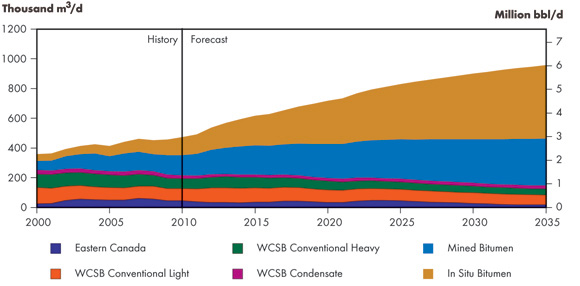ARCHIVED - Fact Sheet - Canada’s Energy Future: Energy Supply and Demand Projections to 2035 - Crude Oil and Bitumen Highlights
This page has been archived on the Web
Information identified as archived is provided for reference, research or recordkeeping purposes. It is not subject to the Government of Canada Web Standards and has not been altered or updated since it was archived. Please contact us to request a format other than those available.
Fact Sheet - Canada’s Energy Future: Energy Supply and Demand Projections to 2035 - Crude Oil and Bitumen Highlights
Canada’s Energy Future: Energy Supply and Demand Projections to 2035 provides a "most likely" Reference Case and four sensitivity cases (based on high and low prices, and fast and slow economic growth) to 2035. The highlights below are based on the Reference Case. For detailed information, please see page 16 of the report.
By 2035, Canada almost doubles 2010 crude oil production rates
- By 2035, Canadian crude oil production in the Reference Case reaches 958 thousand m³/d (6.0 million bbl/d), or about double 2010 production rates.
- In 2035, oil sands account for nearly 85 per cent of production, compared to 54 per cent in 2010.
Total Canadian Oil Production, Reference Case

Production Highlights:
- Oil sands - By 2035, in the Reference Case, oil sands bitumen production is projected to reach 811 thousand m³/d (5.1 million bbl/d), three times the production for 2010. The majority of the growth occurs in the in situ category. In situ projects tend to be smaller and less expensive to build. Also, 80 per cent of the oil sands reserves are considered well suited to in situ extraction, versus 20 per cent for mining methods.[1]
[1] Energy Resources Conservation Board, ERCB ST-98 2011, Alberta’s Energy Reserves 2010 and Supply / Demand Outlook 2011-2020, June 2011. - Oil sands upgrading - Both mining and in situ operations provide bitumen feedstock to upgraders. In 2010, essentially all mined production and about 11 per cent of in situ production was upgraded.[2] In the Reference Case projection, upgraded bitumen volumes roughly double to 302 thousand m³/d (1.9 million bbl/d) by 2035, but do not keep pace with the overall increase in bitumen production. The share of total bitumen production that is upgraded declines from 49 per cent in 2010 to 37 per cent in 2035.
[2] Energy Resources Conservation Board, ERCB ST-98 2011, Alberta’s Energy Reserves 2010 and Supply / Demand Outlook 2011-2020, June 2011. - Eastern Canada - The Newfoundland and Labrador offshore fields are the primary source of production in Eastern Canada. Production in this area has been declining, but this decline will moderate with the addition of two large fields. The Hebron Field is scheduled to begin production in 2017. In the Reference Case, an additional field is assumed to be discovered and commences operation by 2022.
- Western Canada Sedimentary Basin (WCSB) - Conventional crude oil in the WCSB has reversed its long-standing declining trend. Production is ramping up based on the successful application of horizontal drilling and multi-stage hydraulic fracturing methods to tight oil[3] reservoirs. Because this technology is in its infancy and the full impact on future production levels unclear, the incremental production volumes assumed in the projection are limited. Decline resumes in the 2015 to 2016 timeframe.
[3] Tight oil refers to oil produced from organic-rich shales or from low permeability sandstone, siltstone, limestone or dolostone reservoirs. Tight oil reservoirs typically require the combination of horizontal drilling and multi-stage hydraulic fracturing to establish sufficient fluid flow to achieve economic rates of recovery.
Crude Oil Reserves:
- Canada has abundant reserves of crude oil, with remaining reserves of 27.5 billion cubic metres (173 billion barrels). Of this, oil sands bitumen accounts for 98 per cent and conventional crude oil makes up 2 per cent. According to the Oil & Gas Journal, Canada ranks third in the world in terms of oil reserves, behind Saudi Arabia and Venezuela.
- Date modified:
